The homes in the Commonwealth subdivision are, by all accounts, very well constructed and comfortable. But, it’s a miracle they were ever built!
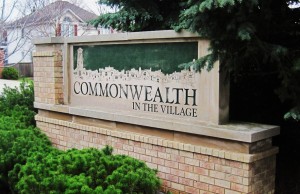
47th Street Entrance to Commonwealth subdivision
In 1958, the new Tri-State Tollway sliced through the western edge of Western Springs. In the process, Flagg (sometimes spelled Flag) Creek was redirected and improved, which reduced many of the village’s previous flooding problems. But, the location of the creek and the new Tollway would limit the type and number of homes that would later become the Commonwealth subdivision.
Many years ago, Commonwealth Avenue had been platted as a north-south street, parallel to Fair Elms Avenue. In this 1938 pre-Tollway aerial photo, you can see the proposed Commonwealth (blue) and Fair Elms (green) with Flagg Creek running between them. But, once the Tollway was built, the land on the west side of Commonwealth was too narrow and irregularly shaped for normal development.
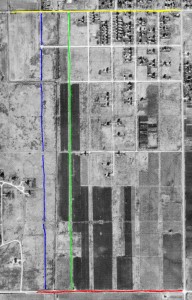
Commonwealth (blue) & Fair elms (green) – 1938
To complicate matters, the narrow strip of land was owned by 20 separate parties. Despite this, developer and life-long village resident Gurrie Rhoads saw the property’s potential and began making plans. In 1986, after working tirelessly to assemble the landowners, he made a presentation to the Village in which he proposed constructing 220 to 240 townhomes on the mile-long, 300-foot-wide piece of property.
The homes would be designed for “empty nesters” who didn’t want to maintain a traditional house and yard, yet still wanted to stay in the village. The homes were to be priced between $125,000 and $200,000. A 12-foot-high noise barrier would also separate the development from the Tollway. At the time, Rhoads described the property as “…a rather difficult site, to say the least.”
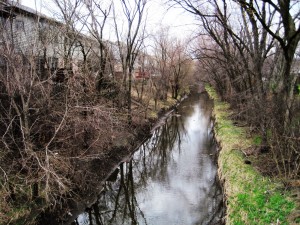
Townhomes (left) along Flagg Creek
At a subsequent meeting of the village’s Plan Commission, a standing-room-only crowd, mostly from Forest Hills, expressed concerns. They focused on traffic safety, the risk of lower property values, the impact on Flagg Creek, and the issue of multi-family vs. single-family homes. Many of these resident’s homes were located directly across Flagg Creek from the new development. So, they were understandably concerned about what the future might hold.
To provide everyone an opportunity to speak, the Plan Commission broke with tradition and met in the Clark Recreation Center’s gymnasium. An estimated 170 people attended the meeting. But, even beforehand, a petition signed by 470 opponents was presented to the Plan Commission. After much discussion, the preliminary concept was approved by the Commission. However, the Village President decided that a five-member citizen committee should be formed to represent the specific concerns of the Forest Hills community. Besides establishing the citizens’ panel, the Village also scheduled three public workshops at McClure Junior High, where the concept plans were reviewed in greater detail.
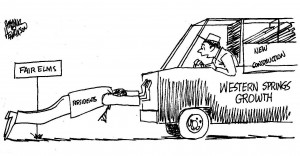
Commonwealth Cartoon – 1986
Amid all of this chaos, a representative from Governor Thompson’s office contacted the Village concerning allegations that “something underhanded” was going on with the project. He said their office had been contacted by residents who were angry with how the development was being handled. However, nothing ever came of the inquiry.
In July 1986, the Village Board took its first look at the proposed development and also heard from the citizens’ panel. However, the Board’s own consultant recommended that, among other things, the number of units be reduced to between 186 and 215, the units be more spread out, and a second bridge be built at 53rd street. After some heated arguments between the Board and Gurrie Rhoads, a compromise was worked out. One component of the compromise was that a detailed report be submitted analyzing the development’s impact on surrounding home values.
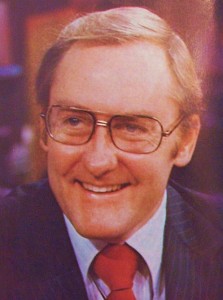
Illinois Gov. James Thompson
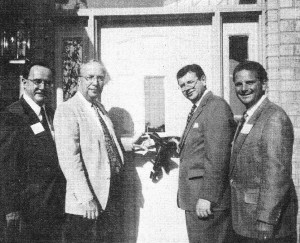
Gurrie Rhoads (left) at Ribbon Cutting – 1994
In late summer, Rhoads reported that the full development package for Commonwealth was taking much longer than anticipated. However, by January 1988, the plan was presented to the Board. But, alas, two of the 20 property owners were not yet on board with the proposal. This caused still more delays as the Village required a revised plan to be filed, which was submitted in early 1989. During the remainder of the year, the plan was updated to address landscaping, water detention, and street lighting concerns. And, in mid-1991, the Plan Commission began reviewing the new proposal.
In the course of further reviews, it was discovered that a 60-inch-diameter sanitary sewer dating back to the 1960’s or 70’s had been located the length of the property, forcing additional redesign. Then there was the matter of a proposed billboard to advertise the new development to Tollway users, subsequently denied. And, if that wasn’t enough, the placement of water lines also became a major issue.
By August of 1991, you’d think that everything that could have been said about the development would have been. But, you would have been wrong. Some 60 residents raised new concerns about possible traffic problems. In the end, the existing 48th street bridge across Flagg Creek would be accessed from the north, redirecting some of the traffic that would otherwise go through Forest Hills.
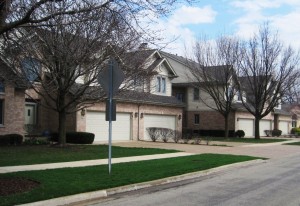
Commonwealth Townhomes – 2013
In October 1991, the Village Board placed some 76 stipulations on the proposed development, to which Rhoads confidently responded, “There is nothing insurmountable.” And, he was right. By late November, the Board gave its official go-ahead for the project. But, by now, the price range for the townhomes was $224,000 to $317,000. A year later, ground was broken for the project and, in 1994, a ribbon was cut at the grand opening of the model homes.
It would be ten more years until the last townhome would be built and sold. But, today the Commonwealth subdivision is a great asset to the community with 396 residents who call Western Springs home.
